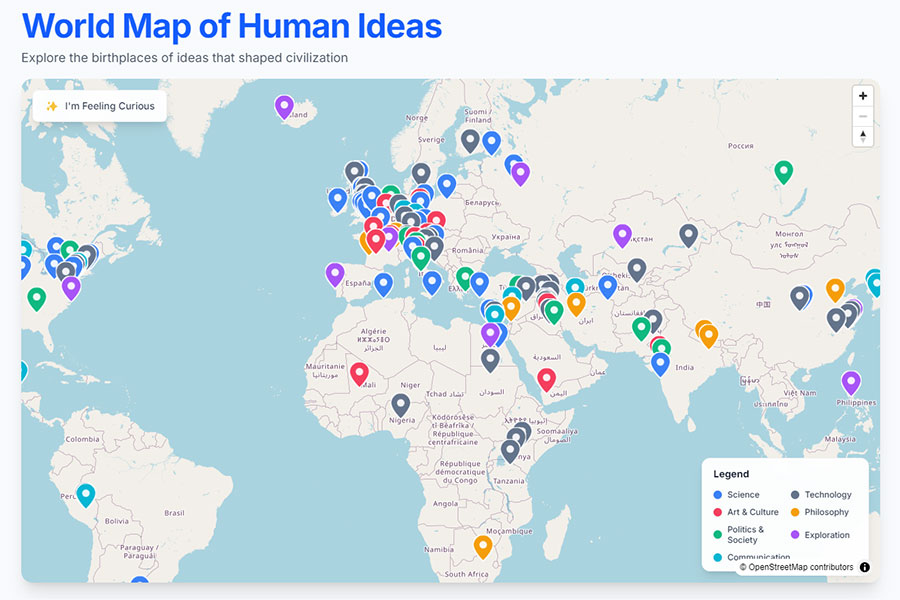
The Map of Human Ideas
AI map tool
Discover where the world’s greatest ideas were born
Website:ideas.zudiay.me
The Map of Human Ideas: An Introduction
Throughout the long river of human civilization, sparks of thought have always burst forth at specific times and places, changing the course of the world. The “The Map of Human Ideas” project, created by Zudiay, is an attempt to materialize these brilliant moments. This interactive map compiles over 250 significant discoveries, philosophical ideas, and inventions that have altered humanity’s collective story, allowing users to intuitively explore the spatio-temporal distribution of human intellect.
The project originated from the creator’s dual passion for maps and history. Conceived as a side project aimed at celebrating curiosity and creativity, it visually presents the geographical roots of ideas. As Steven Shapin, a professor of the history of science at Harvard University, says, “The paths by which ideas spread are just as important as the locations of their origin.” This map happens to offer both perspectives.

Regions and Cities Currently Covered
Based on the content displayed, The Map of Human Ideas primarily focuses on several major global centers of intellectual origin. The European region covers traditional thought hubs like Athens, Florence, Paris, London, and Berlin, marking key ideas from Ancient Greek philosophy to the Enlightenment.
The Asian region includes several ancient capitals of China, such as Xi’an and Luoyang, showcasing contributions like China’s Four Great Inventions and Confucianism. Cities in India, such as Varanasi and Delhi, mark the origins of Buddhism and mathematical concepts. Cities in the Middle East, including Mecca, Baghdad, and Istanbul, reflect the scientific achievements of the Islamic Golden Age.
The Americas primarily cover North American innovation centers like Boston, New York, and Silicon Valley, illustrating the birth of modern technology and political thought. However, as user Michael Kulla points out, the current content remains insufficient, especially the intellectual contributions from Africa, South America, and Oceania may require further expansion.
How the Map and History are Combined
The Map of Human Ideas cleverly organizes content through dual spatio-temporal dimensions. On the timeline, the project spans millennia of human civilization, from ancient times to contemporary innovation. Spatially, it precisely marks the geographical location where each idea originated.
This combination allows users to intuitively discover “hotspots” and “Golden Ages” where ideas clustered. For example, users can observe the explosion of ideas on the Italian peninsula during the Renaissance or the dense innovation in Paris during the Enlightenment. The map also reveals the geographical paths of idea dissemination, such as how the Silk Road facilitated intellectual exchange between the East and West.
The project’s “I’m curious” button design guides users into exploratory learning, similar to the “geography of ideas” approach championed by A History of Human Ideas author Richard Watson, enabling users to discover the spatio-temporal connections between different ideas through interaction.

Shortcomings of The Map of Human Ideas
Despite its novel concept, The Map of Human Ideas still has some notable limitations. The most prominent issue is the uneven content coverage, with a noticeable lack of intellectual contributions from the Global South, which could lead to a skewed understanding of global intellectual history.
Data completeness is also questioned by users, as it currently contains just over 250 entries, which seems sparse compared to the thousands of years of human intellectual accumulation. In contrast, the Stanford Encyclopedia of Philosophy includes over 1,600 entries for thinkers, highlighting the project’s limited breadth of content.
The interactive features are relatively simple, lacking advanced filtering and in-depth search capabilities, making it difficult for users to explore specific fields or periods. User Prajesh Patel’s suggestion for a user contribution system, if implemented, would greatly enrich the map’s content, but for now, it relies on a single creator for updates.
Who is The Map of Human Ideas Suitable For?
The Map of Human Ideas is highly valuable for educators and students, particularly teachers of world history, philosophy, and history of science, who can use it as an intuitive teaching tool to help students understand the geographical dimension of intellectual development.
Curious lifelong learners will find endless joy in exploring this platform. Cross-disciplinary thinkers who enjoy connecting different pieces of knowledge can use the map to discover unexpected correlations between ideas from different fields.
Creators and innovators can also draw inspiration, observing the spatio-temporal environments historically dense with innovation to reflect on the construction of contemporary innovation ecosystems. Writers and researchers can use this tool to trace the geographical origins and historical context of specific ideas.
For the general user, this project offers an easy entry point to human intellectual history. No specialized knowledge is required to gain an intuitive sense of the grand tapestry of human intellect. As the project continues to be refined, it promises to become an important window for the public to understand the evolution of humanity’s collective wisdom.


